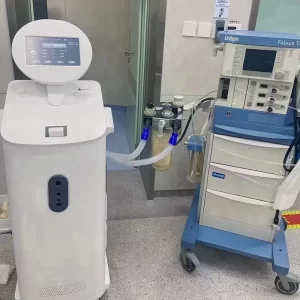In the field of medical care, infection control is crucial to ensure the safety of patients and healthcare workers. One of the most important aspects of infection control is the proper use and maintenance of anesthesia machines. Anesthesia machines are essential in operating rooms and are constantly exposed to various types of contamination. Therefore, it is crucial to properly maintain and clean these machines to prevent the spread of infection.

1. Sodium Lime Tank as a Sterilization Method
Sodium lime is a type of salt that is used as a sterilization agent in hospitals and medical facilities. It is mixed with water to create an alkaline solution that can effectively kill various microorganisms, including bacteria, viruses, and fungi. The use of sodium lime tank as a sterilization method is becoming increasingly popular because it is cost-effective and efficient. It is particularly useful for low-income countries where resources may be limited.
2. Sterilization of Anesthesia Machine Components
Anesthesia machines are complex machines with many different components and tubing. Proper cleaning and sterilization of these components are essential to prevent the spread of infection. Sodium lime tank can effectively sterilize various anesthesia machine components, including the breathing circuit, ventilator, and gas supply system. It is important to ensure that these components are cleaned and sterilized before each use to prevent cross-contamination between patients.
3. Efficiency and Convenience
Sodium lime tank is efficient and convenient for sterilizing anesthesia machine components. It can be easily integrated into the existing anesthesia machine cleaning process without any additional effort or cost. Sodium lime is also widely available and affordable, making it an attractive option for low-resource settings. The use of sodium lime tank also ensures that anesthesia machines are properly disinfected in a timely manner, thereby reducing the risk of infection transmission.

4. Limitations and Challenges
Despite the effectiveness of sodium lime tank as a sterilization method, there are some limitations and challenges associated with its use. Firstly, sodium lime can cause irritation to the eyes and skin if not handled properly. Therefore, it is important to follow appropriate safety measures when using this substance. Additionally, sodium lime may not be as effective in sterilizing certain types of viruses, such as hepatitis B virus and HIV. Therefore, other sterilization methods may need to be employed in conjunction with sodium lime tank to ensure comprehensive disinfection.
5. Comparative Analysis with Other Sterilization Methods
Numerous sterilization methods are available for cleaning anesthesia machines, including steam sterilization, chemical sterilization, and gamma radiation sterilization. Among these methods, sodium lime tank sterilization has several advantages. Firstly, it can be easily integrated into the existing cleaning process, does not require any additional equipment or cost, and is simple to operate. Additionally, sodium lime sterilization does not damage the anesthesia machine components, unlike steam sterilization, which can cause corrosion and damage to the machine components.
6. Conclusion
In conclusion, the anesthesia machine sodium lime tank plays a crucial role in infection control in hospitals and medical facilities. It provides an efficient, cost-effective, and convenient method of sterilizing anesthesia machine components to minimize the risk of infection transmission. However, it is important to follow appropriate safety measures when using sodium lime tank to avoid any potential irritation or harm to the eyes or skin. Sterilization with sodium lime tank has several advantages over other sterilization methods and can be easily implemented in various settings to ensure patient safety and infection control.